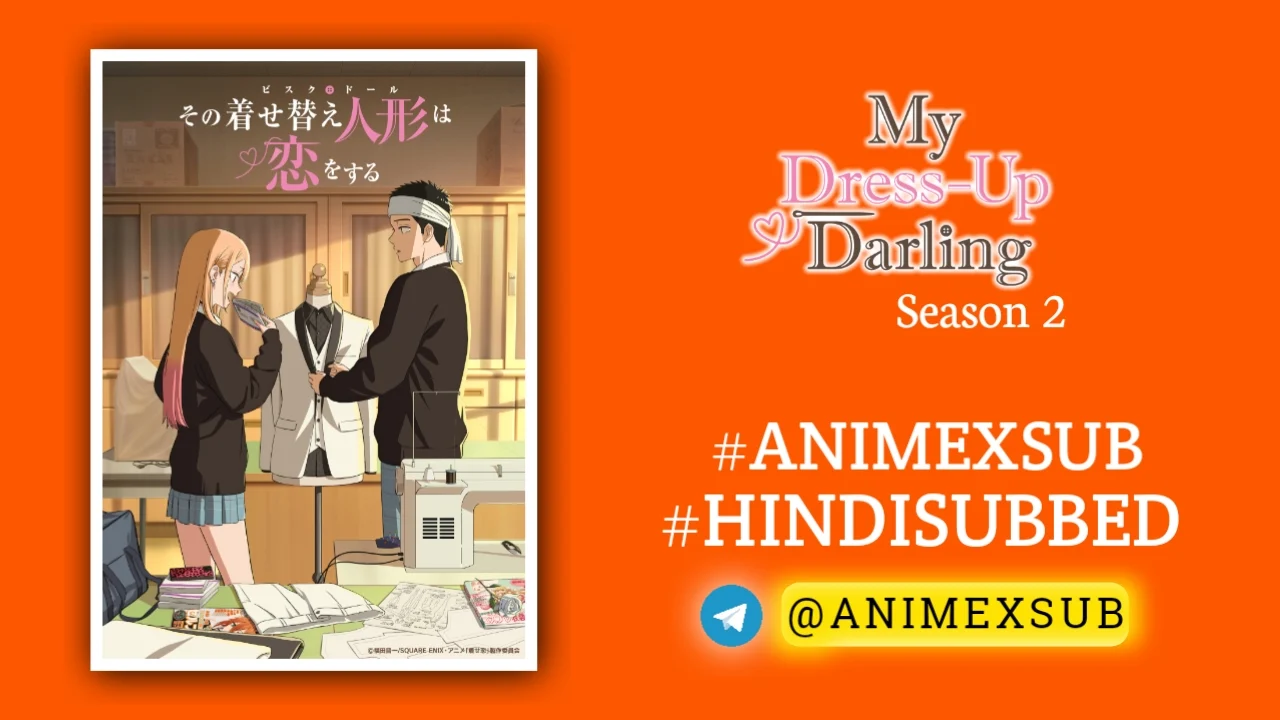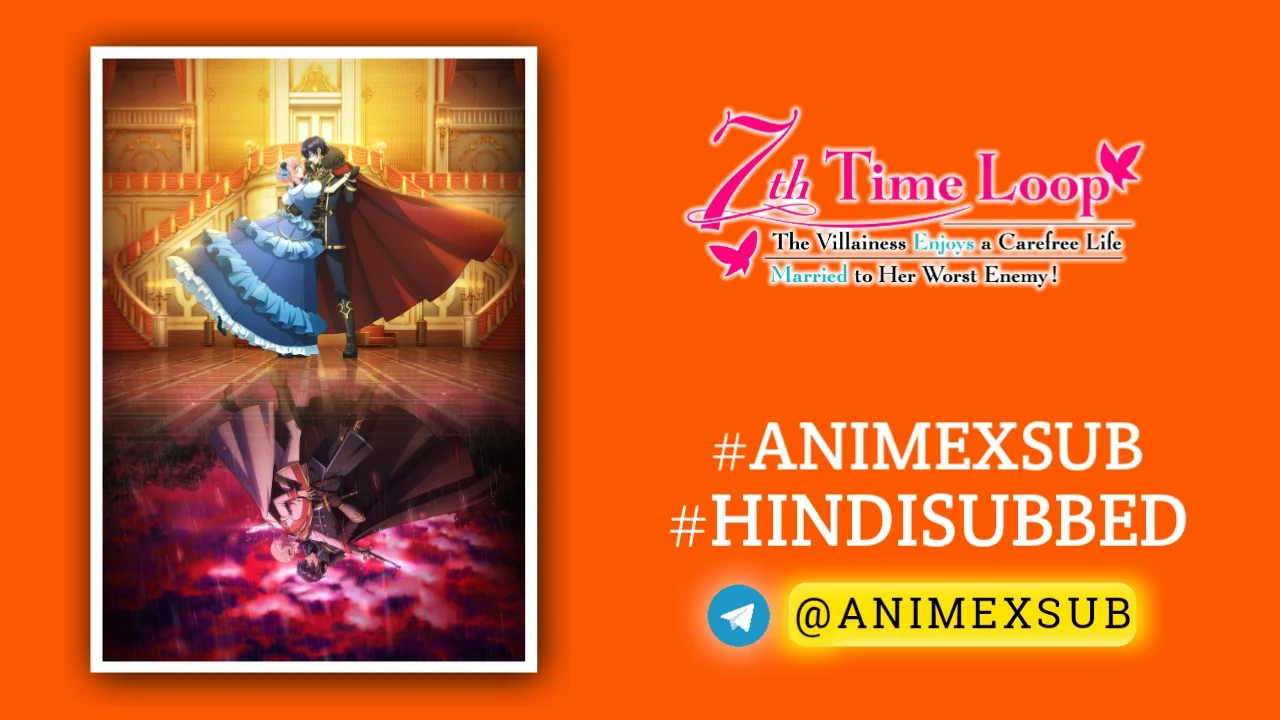
My Dress Up Darling Season 2 Hindi Subbed [11/12] | Sono Bisque Doll wa Koi wo Suru 2nd Season Hindi Sub

Sono Bisque Doll wa Koi wo Suru Season 2
My Dress-Up Darling Season 2Synopsis
The second season of Sono Bisque Doll wa Koi wo Suru. When Marin Kitagawa and Wakana Gojo met, they grew close over their love for cosplay. Through interacting with classmates and making new cosplay friends, Marin and Wakana’s world keeps growing. New developments arise as Marin’s love for Wakana continues to be filled with endless excitement. In their ever-expanding world, Marin and Wakana’s story of cosplay and thrills continues! (Source: Crunchyroll)
Watch Trailer
Characters
Episodes
How To Download Tutorial
My Dress-Up Darling Season 2: Crafting Deeper Connections in a World of Fabric and Fantasy
My Dress-Up Darling Season 2 picks up the threads of its predecessors with a finesse that feels both familiar and evolved, transforming what could have been a straightforward sequel into a nuanced exploration of vulnerability, craftsmanship, and the blurred lines between hobby and identity. Airing from July 5, 2025, to September 21, 2025, on networks like Tokyo MX and streamed globally via Crunchyroll, this 12-episode cour from CloverWorks adapts further chapters of Shinichi Fukuda’s manga, which concluded its serialization in March 2025 after 15 volumes. What emerges is not just more cosplay escapades but a story that delves into the emotional undercurrents of its characters, making it a standout in the Summer 2025 anime lineup for its balance of whimsy and introspection.
Plot Progression: From Shared Secrets to Shared Stages
The season resumes shortly after the events of Season 1, with Wakana Gojo and Marin Kitagawa’s partnership in cosplay now a well-oiled routine, yet laced with unspoken tensions. Episode 1, titled “Wakana Gojo, 15 Years Old, Teenager,” reintroduces their dynamic through Marin’s latest obsession: a hyper-detailed cosplay of a character from a niche visual novel, demanding Gojo’s meticulous sewing skills. As the narrative unfolds, the plot shifts from intimate one-on-one collaborations to larger group dynamics, incorporating school festivals and cosplay conventions where their creations face public scrutiny.
Key arcs include the School Festival storyline, where Marin experiments with crossplay—embodying a male character—which challenges traditional gender norms in fandom spaces and adds layers to her performative identity. Later episodes introduce conflicts like costume malfunctions during events and interpersonal rivalries among fellow cosplayers, such as the enigmatic Akira, whose backstory unfolds in Episode 11 as a poignant parallel to Gojo’s own insecurities. The season builds toward a climactic convention appearance, weaving in subplots about Marin’s academic pressures and Gojo’s family legacy in doll-making. Unlike Season 1’s focus on initiation, this installment emphasizes sustainability: how passions endure beyond the initial thrill, tested by real-world logistics and emotional stakes.
What sets this season apart is its refusal to rush romance. Subtle moments—like Gojo memorizing Marin’s measurements not just for practicality but as an act of quiet devotion—heighten the tension without overt confessions, mirroring the manga’s deliberate pacing.
Character Development: Peeling Back the Layers of Fabric
At its core, Season 2 amplifies character growth, turning Gojo and Marin from endearing archetypes into fully realized individuals grappling with self-doubt. Gojo’s arc is particularly transformative; once crippled by his fear of judgment over his hina doll aspirations, he now confronts how his introversion isolates him even among like-minded friends. Episode 9’s horror visual novel cosplay sequence forces him to vocalize his boundaries, marking a shift from passive observer to active participant in social circles. This evolution is subtle yet profound, as seen in his interactions with new characters like Sajuna Inui, whose petite stature and bold personality contrast his own, pushing him to mentor rather than withdraw.
Marin’s development, meanwhile, explores the double-edged sword of her extroverted enthusiasm. Her unbridled joy in cosplay often masks deeper anxieties about being perceived as superficial, a theme that peaks in Episode 11 when she opens up about the “revealing” aspects of her hobby drawing unwanted attention. The season humanizes her by showing the exhaustion behind her smiles—late nights perfecting poses, the sting of online criticism—and how Gojo’s steadfast support becomes her anchor. Supporting cast members shine too: Grandparent figures like Gojo’s grandfather provide wisdom on legacy, while cosplay veterans like Miyako introduce themes of generational passion, revealing how hobbies evolve without losing their essence.
A unique angle emerges in the ensemble’s diversity; queer undertones in group scenes affirm cosplay as an inclusive space, with characters encouraging fluid expressions of identity. This isn’t tokenism but a natural extension of the series’ ethos, where acceptance blooms from shared vulnerability.
Themes: The Intersection of Craft, Identity, and Intimacy
My Dress-Up Darling has always celebrated subcultures, but Season 2 elevates this into a meditation on authenticity. Cosplay here isn’t mere escapism; it’s a metaphor for constructing one’s true self, stitch by stitch. The show dissects how societal expectations—Gojo’s “weird” doll-making, Marin’s “otaku” obsessions—foster insecurity, yet communal spaces like conventions dismantle these barriers. Episode 20’s subtle nod to hobbyist eccentricity, with Miyako posing her character plushies at meals, validates Gojo’s quirks, underscoring a theme of normalization: what seems obsessive to outsiders is profound devotion within the circle.
Identity ties closely to intimacy, as physical closeness in sewing sessions mirrors emotional proximity. The season probes consent and boundaries, especially in ecchi-tinged moments like wardrobe fittings, framing them as trust-building exercises rather than fanservice. Broader societal commentary creeps in via the manga’s post-hiatus context; with the source material’s abrupt 2025 ending due to the author’s health, the anime feels like a loving capstone, emphasizing resilience in creative pursuits.
Animation and sound design amplify these themes. CloverWorks’ stylized visuals—fluid fabric simulations and exaggerated expressions during cosplay reveals—capture the tactile joy of creation, while Spira Spica’s opening “Blue and Sparkle” evokes sparkling determination, and PiKi’s ending “Kawaii Kaiwai” adds a playful whimsy.
Animation and Production: Elevated Craftsmanship
CloverWorks returns with a production that feels refined, building on Season 1’s strengths while incorporating lessons from their diverse portfolio. Character designs by Kazumasa Ishida retain the expressive charm, but dynamic camera work during cosplay sequences—close-ups on needlework or sweeping convention shots—immerses viewers in the process. Episodes like 5 (“800 Million”) showcase meticulous detail in costume assembly, with lighting that highlights textures, turning technical scenes into visual poetry.
Voice acting remains a highlight: Hina Matsumura’s Marin bursts with infectious energy, while Shoya Ishige’s Gojo conveys quiet depth. The score by Takeshi Nakatsuka blends upbeat pop with tender piano interludes, syncing perfectly with emotional beats. Minor pacing hiccups in filler-like subplots aside, the overall polish rivals CloverWorks’ best, making every frame a testament to the show’s meta-love for artistry.
Reception: A Resonant Return Amid Mixed Manga Shadows
Critics and fans alike have praised Season 2 for recapturing the original’s heart while pushing boundaries. IGN echoes its Season 1 review, calling it a “genuine portrayal of shared craft,” with Anime News Network noting the “stylized animation bleeding through from other projects.” 38 On platforms like MyAnimeList, it holds an 8.35 score, buoyed by discussions on Reddit and X about its empathetic handling of insecurities. 41 X users highlight emotional episodes like 11, where Akira’s vulnerability resonates, fostering conversations on passion’s universality. 7 Yet, some critique the manga’s rushed conclusion influencing the finale’s bittersweet tone, though the anime’s adaptations mitigate this with added depth.
Comparisons to peers like Rent-A-Girlfriend underscore its edge: where others lean on tropes, My Dress-Up Darling grounds romance in mutual growth, earning nearly 200,000 trackers on MyAnimeList pre-premiere. 28 Queer fans appreciate its affirming moments, positioning it as progressive in rom-com spaces. 45
Why Season 2 Redefines the Genre’s Potential
In a sea of formulaic romances, My Dress-Up Darling Season 2 stands as a beacon of thoughtful storytelling, using cosplay not as backdrop but as catalyst for profound change. It reminds us that true connection arises from embracing flaws—be it a seamstress’s shyness or a model’s hidden fears—crafting a narrative as enduring as the costumes it depicts. As the credits roll on this chapter, it leaves viewers not just entertained, but inspired to stitch their own stories.1






























